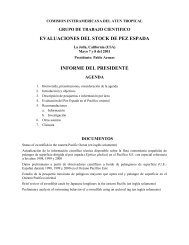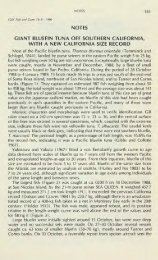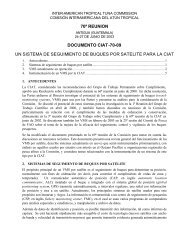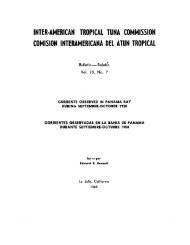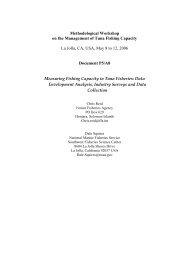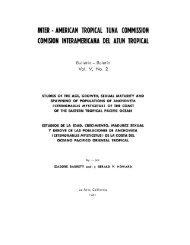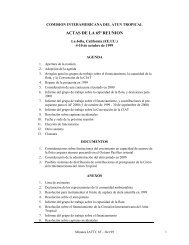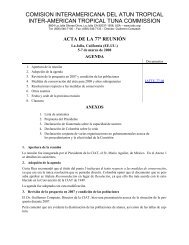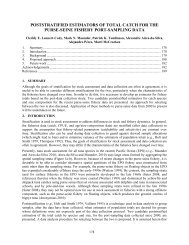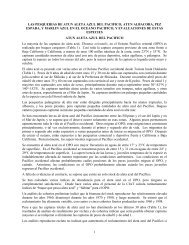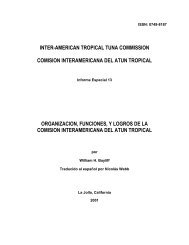Informe Anual de la Comisión Interamericana del Atún Tropical, 19
Informe Anual de la Comisión Interamericana del Atún Tropical, 19
Informe Anual de la Comisión Interamericana del Atún Tropical, 19
You also want an ePaper? Increase the reach of your titles
YUMPU automatically turns print PDFs into web optimized ePapers that Google loves.
24 TUNA COMMISSION<br />
average, however, ifthere is a 1:1 ratio of sexes produced, only 2of all the eggs produced in a lifetime<br />
will survive to maturity, and perhaps only about 501' 10 will survive to recruitment into the fishery. It<br />
is difficult to monitor the changes in the abundance of <strong>la</strong>rval and juvenile fishes of any species<br />
directly by sampling in the ocean, and to do this for yellowfin ayer its entire range would be totally<br />
impracticable. Therefore fisheries scientists try to find statistical re<strong>la</strong>tionships between recruits and<br />
the spawners which produced them. These efforts are not usually very successful, as the residual<br />
variance after the statistical mo<strong>de</strong>l has been fitted is in most cases so <strong>la</strong>rge that the results cannot be<br />
used to predict recruitment. Instead the re<strong>la</strong>tive abundance ofthe recruits is estimated from fishery<br />
data, and the fishery is managed on that basis. This is how the IATTC staff uses cohort analyses to<br />
assess the condition ofthe yellowfin stock in the eastern Pacific and make recommendations for its<br />
management.<br />
Density-<strong>de</strong>pen<strong>de</strong>nt mechanisms must operate at some level of abundance for any species, so<br />
that at levels less than the natural carrying capacity a popu<strong>la</strong>tion must be more likely to increase<br />
than to <strong>de</strong>crease, and at levels greater than the natural carrying capacity the opposite must be the<br />
case. These mechanisms ameliorate an otherwise stochastic environment: when the popu<strong>la</strong>tion is<br />
reduced the chances of survival for each individual are improved, which reduces the probability that<br />
the popu<strong>la</strong>tion will become extinct; simi<strong>la</strong>rly, at high popu<strong>la</strong>tion levels the growth ofthe popu<strong>la</strong>tion is<br />
curtailed so that it is unlikely to increase further. Density <strong>de</strong>pen<strong>de</strong>nce is usually most apparent in<br />
the fertility ofthe adults 01' the survival ofthe young. Adults may forego 01' reduce reproduction when<br />
the <strong>de</strong>nsity is great, while the the young tend to have fewer reserves to buffer them against the<br />
environment. When popu<strong>la</strong>tions of animals are mo<strong>de</strong>led mathematically it is often found that<br />
<strong>de</strong>nsity <strong>de</strong>pen<strong>de</strong>nce, particu<strong>la</strong>rly when associated with <strong>de</strong><strong>la</strong>ys which are inherent in reproduction,<br />
can cause cycles in their abundance. This has been most clearly <strong>de</strong>monstrated for insect popu<strong>la</strong>tions.<br />
Fish popu<strong>la</strong>tions, in most cases, are re<strong>la</strong>tively stable because several year c<strong>la</strong>sses are<br />
important contributors to egg production. (Pacific salmon, however, spawn only once, and then die,<br />
and the popu<strong>la</strong>tions of these are subject to wi<strong>de</strong> f1uctuations and persistent cycles.) It might be<br />
expected that, since the mortality rates of fish are generally high, the youngest age group ofmature<br />
fish would contribute by far the greatest numbers ofeggs, and when the abundance ofthat age group<br />
was especially low 01' especially high the production of eggs, and subsequently of recruits, would be<br />
reduced 01' increased. Fish, however, unlike most animals which have been studied, continue to grow<br />
after they reach maturity. Since the fecundity is approximately proportional to the weight ofthe fish,<br />
the ol<strong>de</strong>r fish have much greater fecundities than the younger ones. Ifover several years the loss of<br />
individuals to a cohort roughly equals the gain in weight of the individuals which survive the<br />
production of eggs of that cohort remains roughly constant ayer that periodo This results in more<br />
stable recruitment than would be the case if the fish ceased to grow after reaching maturity. The<br />
estimated biomasses of yellowfin of the various ages which are caught by the fishery are shown in<br />
Figure 32. Age-1, -2, and -3 fish contributed the greatest biomasses in 14,5, and 2cases, respectively,<br />
and age-4 and -5 fish are significant contributors in many years. Reproduction is thus not almost<br />
exclusively <strong>de</strong>pen<strong>de</strong>nt on the abundance of a single age group, which might create instabilities, and<br />
the popu<strong>la</strong>tion is stable enough that any re<strong>la</strong>tionship between stock and recruitment is masked by<br />
other factors which are not yet un<strong>de</strong>rstood.<br />
If spawner-recruit studies are to be usefui a long series of data on the total weights of<br />
spawners and the resulting numbers ofrecruits must first be assembled to obtain an un<strong>de</strong>rstanding<br />
of <strong>de</strong>nsity <strong>de</strong>pen<strong>de</strong>nce. Then, after an a<strong>de</strong>quate un<strong>de</strong>rstanding of the spawner-recruit re<strong>la</strong>tionship<br />
has been obtained, the amount of recruitment can be predicted from the total weight of spawners,<br />
provi<strong>de</strong>d the re<strong>la</strong>tionship is not highly variable. Itis necessary for spawner-recruit studies, ofcourse,<br />
to have reasonably accurate estimates ofthe total weight of spawners and of the numbers of recruits<br />
produced. These can be obtained from catch-per-unit-of-effort data, provi<strong>de</strong>d catch per unit of effort<br />
provi<strong>de</strong>s a suitable measure of abundance and maturity occurs after recruitment. If, however, the



